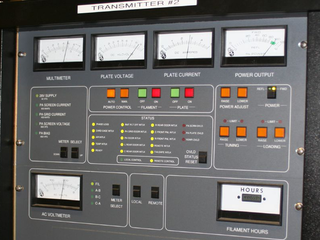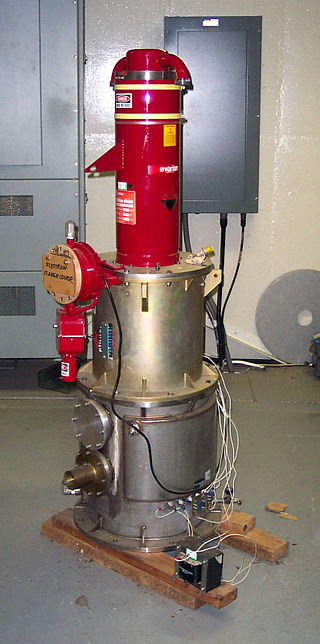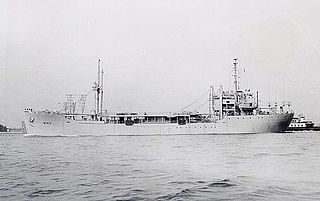
The Collins 207B-1 was a radio transmitter manufactured in 1951 by Collins Radio Company.

The Collins 207B-1 was a radio transmitter manufactured in 1951 by Collins Radio Company.
The 207B-1 was capable of 35 kilowatts of RF output in amplitude modulation mode, and 50 kilowatts in continuous wave mode. The transmitter was designed for land-based operation within the frequencies of 4 to 26 MHz and was contained within five sheet metal cabinets bolted together to form a single unit with a weight of 16,800 pounds. Intended primarily for high speed telegraphy and broadcasting, the 207B-1 was capable of high power AM transmission and telegraphic or frequency-shift keying at speeds greater than 400 words per minute. It could also be used to amplify the power output of a single-sideband modulation transmitter to a peak envelope power of 30 kilowatts. [1] [2]
In April 1951 the United States Coast Guard Cutter USCGC Courier was equipped with two 207B-1 transmitters during its time as a ship-borne radio relay station to transmit Voice of America programs behind the Iron Curtain. [3] [4]

In telecommunications, orthogonal frequency-division multiplexing (OFDM) is a type of digital transmission used in digital modulation for encoding digital (binary) data on multiple carrier frequencies. OFDM has developed into a popular scheme for wideband digital communication, used in applications such as digital television and audio broadcasting, DSL internet access, wireless networks, power line networks, and 4G/5G mobile communications.

Frequency-shift keying (FSK) is a frequency modulation scheme in which digital information is encoded on a carrier signal by periodically shifting the frequency of the carrier between several discrete frequencies. The technology is used for communication systems such as telemetry, weather balloon radiosondes, caller ID, garage door openers, and low frequency radio transmission in the VLF and ELF bands. The simplest FSK is binary FSK, in which the carrier is shifted between two discrete frequencies to transmit binary information.

In electronics and telecommunications, a radio transmitter or just transmitter is an electronic device which produces radio waves with an antenna with the purpose of signal transmission up to a radio receiver. The transmitter itself generates a radio frequency alternating current, which is applied to the antenna. When excited by this alternating current, the antenna radiates radio waves.

Citizens band radio is a land mobile radio system, a system allowing short-distance one-to-many bidirectional voice communication among individuals, using two-way radios operating near 27 MHz in the high frequency or shortwave band. Citizens band is distinct from other personal radio service allocations such as FRS, GMRS, MURS, UHF CB and the Amateur Radio Service. In many countries, CB operation does not require a license and may be used for business or personal communications.

Radio control is the use of control signals transmitted by radio to remotely operate a device. Examples of simple radio control systems are garage door openers and keyless entry systems for vehicles, in which a small handheld radio transmitter unlocks or opens doors. Radio control is also used for control of model vehicles from a hand-held radio transmitter. Industrial, military, and scientific research organizations make use of radio-controlled vehicles as well. A rapidly growing application is control of unmanned aerial vehicles for both civilian and military uses, although these have more sophisticated control systems than traditional applications.

A klystron is a specialized linear-beam vacuum tube, invented in 1937 by American electrical engineers Russell and Sigurd Varian, which is used as an amplifier for high radio frequencies, from UHF up into the microwave range. Low-power klystrons are used as oscillators in terrestrial microwave relay communications links, while high-power klystrons are used as output tubes in UHF television transmitters, satellite communication, radar transmitters, and to generate the drive power for modern particle accelerators.
A continuous wave or continuous waveform (CW) is an electromagnetic wave of constant amplitude and frequency, typically a sine wave, that for mathematical analysis is considered to be of infinite duration. It may refer to e.g. a laser or particle accelerator having a continuous output, as opposed to a pulsed output.

Rockwell Collins, Inc. was a multinational corporation headquartered in Cedar Rapids, Iowa, providing avionics and information technology systems and services to government agencies and aircraft manufacturers. It was formed when the Collins Radio Company, facing financial difficulties, was purchased by Rockwell International in 1973. In 2001, the avionics division of Rockwell International was spun off to form the current Rockwell Collins, Inc., retaining its name.

An Alexanderson alternator is a rotating machine, developed by Ernst Alexanderson beginning in 1904, for the generation of high-frequency alternating current for use as a radio transmitter. It was one of the first devices capable of generating the continuous radio waves needed for transmission of amplitude modulated (AM) signals by radio. It was used from about 1910 in a few "superpower" longwave radiotelegraphy stations to transmit transoceanic message traffic by Morse code to similar stations all over the world.
The aircraft emergency frequency is a frequency used on the aircraft band reserved for emergency communications for aircraft in distress. The frequencies are 121.5 MHz for civilian, also known as International Air Distress (IAD) or VHF Guard, and 243.0 MHz—the second harmonic of VHF guard—for military use, also known as Military Air Distress (MAD) or UHF Guard. Earlier emergency locator transmitters (ELTs) used the guard frequencies to transmit, but an additional frequency of 406 MHz is used by a more modern emergency locator transmitter.

A class-D amplifier or switching amplifier is an electronic amplifier in which the amplifying devices operate as electronic switches, and not as linear gain devices as in other amplifiers. They operate by rapidly switching back and forth between the supply rails, using pulse-width modulation, pulse-density modulation, or related techniques to produce a pulse train output. A simple low-pass filter may be used to attenuate their high-frequency content to provide analog output current and voltage. Little energy is dissipated in the amplifying transistors because they are always either fully on or fully off, so efficiency can exceed 90%.

The USCGC Courier (WAGR/WTR-410) was a cutter in the United States Coast Guard converted from the M/V Coastal Messenger a Maritime Commission Type C1-M-AV1 vessel.
A radio transmitter or just transmitter is an electronic device which produces radio waves with an antenna. Radio waves are electromagnetic waves with frequencies between about 30 Hz and 300 GHz. The transmitter itself generates a radio frequency alternating current, which is applied to the antenna. When excited by this alternating current, the antenna radiates radio waves. Transmitters are necessary parts of all systems that use radio: radio and television broadcasting, cell phones, wireless networks, radar, two way radios like walkie talkies, radio navigation systems like GPS, remote entry systems, among numerous other uses.
The Domžale radio transmitter is a former facility for medium wave broadcasting in Domžale, in Slovenia. The transmitter is fully transistorized. It could be received easily at a medium wave frequency of 918 kHz across the whole of Europe at night-time. It was the strongest radio transmitter of the Republic of Slovenia, broadcasting the first national radio channel.

An amateur radio repeater is an electronic device that receives a weak or low-level amateur radio signal and retransmits it at a higher level or higher power, so that the signal can cover longer distances without degradation. Many repeaters are located on hilltops or on tall buildings as the higher location increases their coverage area, sometimes referred to as the radio horizon, or "footprint". Amateur radio repeaters are similar in concept to those used by public safety entities, businesses, government, military, and more. Amateur radio repeaters may even use commercially packaged repeater systems that have been adjusted to operate within amateur radio frequency bands, but more often amateur repeaters are assembled from receivers, transmitters, controllers, power supplies, antennas, and other components, from various sources.
The inductive output tube (IOT) or klystrode is a variety of linear-beam vacuum tube, similar to a klystron, used as a power amplifier for high frequency radio waves. It evolved in the 1980s to meet increasing efficiency requirements for high-power RF amplifiers in radio transmitters. The primary commercial use of IOTs is in UHF television transmitters, where they have mostly replaced klystrons because of their higher efficiencies and smaller size. IOTs are also used in particle accelerators. They are capable of producing power output up to about 30 kW continuous and 7 MW pulsed and power gains of 20–23 dB at frequencies up to about a gigahertz.

The 74A4 and KWS-1 is an amateur radio receiver and transmitter pair made by the Collins Radio Company of Cedar Rapids, Iowa that were introduced in 1955. They were designed to operate using the then new single-sideband (SSB) voice modulation as well as CW and AM modes. They were influential in popularizing SSB.

R-350M "Eagle" is a Soviet portable short-wave radio transceiver designed for covert operations.